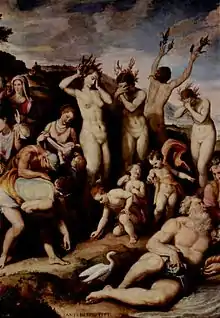Heliades
In Greek mythology, the Heliades (Greek: Ἡλιάδες, "children of the sun") were the daughters of Helios and Clymene the Oceanid.
| Greek deities series |
|---|
| Nymphs |


Names
According to one version recorded by Hyginus, there were three of them: Aegiale, Aegle, and Aetheria. According to another version, there were five: Helia, Merope, Phoebe, Aetheria and Dioxippe.[1] Aeschylus's fragmentary Heliades[2][3] names Phaethousa and Lampetia, who are otherwise called daughters of Neaera.[4]
Mythology
Their brother, Phaëthon, died after attempting to drive his father's chariot (the sun) across the sky. He was unable to control the horses and fell to his death (according to most accounts, Zeus struck his chariot with a thunderbolt to save the Earth from being set afire). The Heliades grieved for four months and the gods turned them into poplar trees and their tears into amber.[5][6] According to some sources, their tears (amber) fell into the river Eridanos, in which Phaethon had fallen.[7][8][9]
According to Hyginus, the Heliades were turned to poplar trees because they yoked the chariot for their brother without their father Helios' permission.[10]
Notes
- Hyginus, Fabulae 154
- Aeschylus, Heliades (play survived only in brief fragments)
- Ovid, Metamorphoses 2.340
- Homer, Odyssey 12.128
- Diodorus Siculus, Bibliotheca historica 5.23.2
- Ovid, Metamorphoses 10.262 ff
- Philoxenus of Cythera, Fragment 834
- Pausanias, Graeciae Descriptio 1.4.1
- Quintus Smyrnaeus, Posthomerica 5.627 ff
- Hyginus, Fabulae 152A
References
- Diodorus Siculus, The Library of History translated by Charles Henry Oldfather. Twelve volumes. Loeb Classical Library. Cambridge, Massachusetts: Harvard University Press; London: William Heinemann, Ltd. 1989. Vol. 3. Books 4.59–8. Online version at Bill Thayer's Web Site
- Diodorus Siculus, Bibliotheca Historica. Vol 1-2. Immanel Bekker. Ludwig Dindorf. Friedrich Vogel. in aedibus B. G. Teubneri. Leipzig. 1888–1890. Greek text available at the Perseus Digital Library.
- Gaius Julius Hyginus, Fabulae from The Myths of Hyginus translated and edited by Mary Grant. University of Kansas Publications in Humanistic Studies. Online version at the Topos Text Project.
- Homer, The Odyssey with an English Translation by A.T. Murray, PH.D. in two volumes. Cambridge, MA., Harvard University Press; London, William Heinemann, Ltd. 1919. Online version at the Perseus Digital Library. Greek text available from the same website.
- Pausanias, Description of Greece with an English Translation by W.H.S. Jones, Litt.D., and H.A. Ormerod, M.A., in 4 Volumes. Cambridge, MA, Harvard University Press; London, William Heinemann Ltd. 1918. Online version at the Perseus Digital Library
- Pausanias, Graeciae Descriptio. 3 vols. Leipzig, Teubner. 1903. Greek text available at the Perseus Digital Library.
- Publius Ovidius Naso, Metamorphoses translated by Brookes More (1859-1942). Boston, Cornhill Publishing Co. 1922. Online version at the Perseus Digital Library.
- Publius Ovidius Naso, Metamorphoses. Hugo Magnus. Gotha (Germany). Friedr. Andr. Perthes. 1892. Latin text available at the Perseus Digital Library.
- Quintus Smyrnaeus, The Fall of Troy translated by Way. A. S. Loeb Classical Library Volume 19. London: William Heinemann, 1913. Online version at theio.com
- Quintus Smyrnaeus, The Fall of Troy. Arthur S. Way. London: William Heinemann; New York: G.P. Putnam's Sons. 1913. Greek text available at the Perseus Digital Library.
- Smith, William; Dictionary of Greek and Roman Biography and Mythology, London (1873). "Heliadae and Heliads"
![]() This article incorporates text from a publication now in the public domain: Smith, William, ed. (1870). Dictionary of Greek and Roman Biography and Mythology. Missing or empty
This article incorporates text from a publication now in the public domain: Smith, William, ed. (1870). Dictionary of Greek and Roman Biography and Mythology. Missing or empty |title= (help)
External links
 Media related to Heliades at Wikimedia Commons
Media related to Heliades at Wikimedia Commons